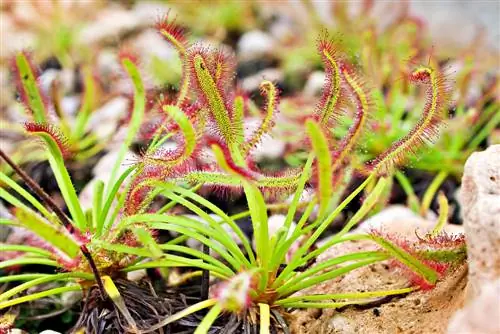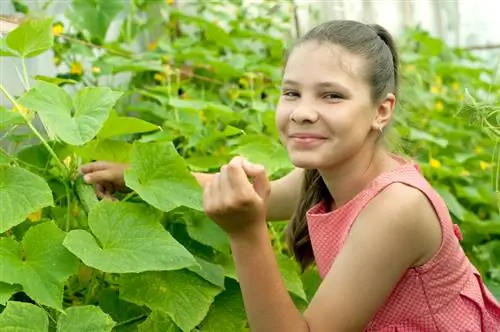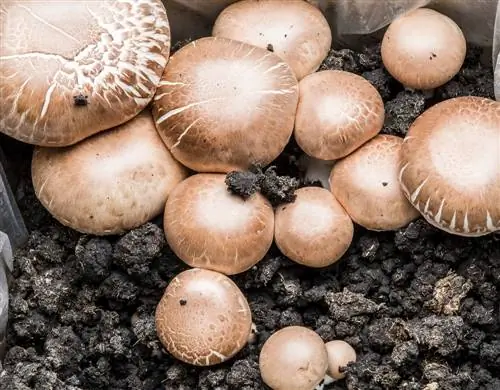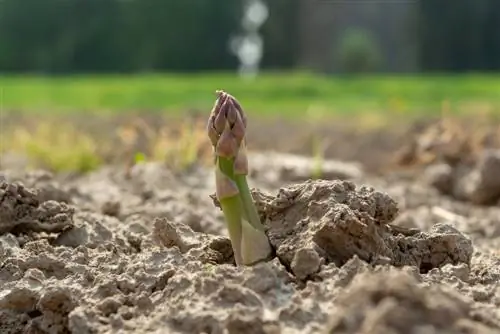- Author admin [email protected].
- Public 2023-12-16 16:46.
- Last modified 2025-06-01 06:02.
Read a commented sundew profile here with information about growth, leaves, flowers and beautiful species. Many tips and tricks explain how to properly plant and care for the carnivorous plant.
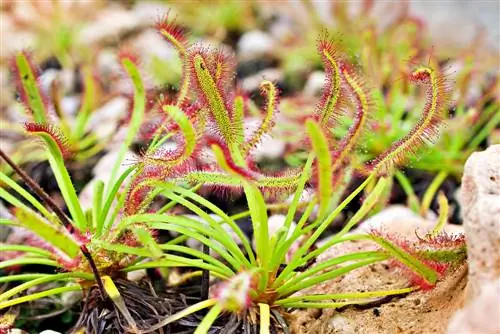
How do I properly care for a sundew?
The sundew (Drosera) is a carnivorous plant with sticky leaves and small flowers. It prefers sunny to very bright locations with high humidity levels. The plant requires nutrient-poor, boggy, moist soil and should be kept constantly moist. Use lime-free water for watering and avoid fertilizer.
Profile
- Scientific name: Drosera
- Family: Sundew family (Droseraceae)
- Occurrence: Eurasia, South America, South Africa
- Growth type: carnivorous plant
- Growth height: 10 cm to 100 cm
- Leaf: rich in shapes
- Flower: Wrap
- Fruit: Capsule
- Survival organ: hibernacle
- Toxicity: non-toxic
- Winter hardiness: hardy or sensitive to frost
- Use: bog bed, potted garden, houseplant, medicinal plant
Growth
Sundews, with more than 200 diverse species, form the second largest genus of carnivorous plants, also known as carnivores. Drosera species occur almost worldwide. The main distribution areas extend across South America, South Africa and Australia. A few survivalists settle Europe, Asia and North America right up to the edge of the Arctic. Regardless of the biodiversity and cosmopolitan occurrence, the essential characteristics of sundew growth can be summarized:
- Growth type: unorthodox perennial as a carnivorous plant (carnivore) with sticky fang leaves and small flowers on the long stem.
- Growth form: rosette-forming, upright, very rarely climbing.
- Growth height: 10 cm to 100 cm, climbing species up to 300 cm
- Root system: weakly developed; primarily serves to absorb water and anchor it in the substrate.
- Survival organ: hibernacle (winter bud) or rarely a tuber.
- Gardenically interesting properties: native species are hardy and easy to care for, exotic species are more demanding, non-toxic, long-lasting, extravagant bedding, balcony and house plants.
Leaf
A sundew leaf is movable and primarily serves as an insect trap with an adhesive effect. The shape and texture are geared towards this function with the following features:
- Leaf shape: stalked or sessile, rounded, spatulate, elongated-linear to narrow-grass-like.
- Special feature: movable tentacles covered with sugary-sticky secretions on the leaf surface and on the edge of the leaf, which shimmer promisingly in the sunlight.
- Leaf color: green with whitish tentacles that turn red in intense sunlight.
- Life phases: native species deciduous, tropical species evergreen.
This is how the catching mechanism works: Insects attracted by the shimmer get stuck on the sticky tentacles. The tentacles lean towards the insect for better adhesion. The captured victims die of exhaustion or suffocation. The plant now releases certain digestive enzymes. Over the next few hours, the blade curls up and encloses the prey until it is completely digested. What remains is the indigestible residue. The following video demonstrates the fascinating process:
Video: Round-leaved sundew hunting for prey in the raised moor
Bloom
The sundew flowers sit at a safe distance from the sticky leaves. With this precaution, the carnivorous plant prevents pollinator insects from falling into the trap. All the important characteristics of a Drosera flower at a glance:
- Inflorescence: coil of several individual flowers on a stem up to 40 cm long.
- Single flower: five-fold, radiating, up to 1.5 cm in diameter.
- Special feature: heliotropic (flower faces the sun).
- Flower color: white, light purple, pink or red.
- Flower ecology: hermaphrodite
Sundew species
In Europe there are three Drosera species that are also suitable for year-round cultivation in the garden. Some exotic sundew species are very valued as houseplants in this country. The following table provides a compact overview:
| Sundew species | Round-leaved sundew | Long-leaved sundew | Medium Sundew | Star Sundew | Cape Sundew |
|---|---|---|---|---|---|
| Botanical name | Drosera rotundifolia | Drosera anglica | Drosera intermedia | Drosera peltata | Drosera capensis |
| Growth height (without flowers) | 10cm | 15cm | 10cm | 25 cm | 10cm |
| Leaf shape | long-stemmed, round | petiolate, linear to obovate | stemmed, spatulate | petiolate, elliptical-concave | stemless, grass-like |
| Sheet size (L/W) | 5-18mm | 15-35mm, 2-5mm | 2-4mm, 4-8mm | 4-16mm, 1-8mm | 70mm, 5mm |
| Flowering time | June to August | June to July | July to August | Spring | December to January |
| Flower color | white | white | white | white | light purple |
| Winter hardiness | hardy | hardy | hardy | sensitive to frost | sensitive to frost |
Also interesting for cultivation as a houseplant: South African sundew (Drosera aliciae) with red inflorescences up to 40 centimeters high, which bloom in winter over a 6 centimeter small rosette made of 30 leaves.
Usage
The origin determines the possible uses of the sundew in the hobby garden. Get inspired by these ideas:
- Graceful eye-catcher in the moorland (e.g. frost-hardy round-leaved sundew).
- Decorative bank plant for garden ponds and streams (e.g. hardy long-leaved sundew).
- Extravagant potted plant on the south-facing balcony (e.g. cold-tolerant medium sundew).
- Effective eye-catcher in a beautiful flower pot on the windowsill (e.g. exotic star sundew).
- Noteworthy houseplant for the temperate winter garden (e.g. winter-flowering Cape sundew).
Initiated herbalists are familiar with sundew as a historical medicinal plant. Since the 12th century, round-leaved sundew (Drosera rotundifolia) and medium sundew (Drosera intermedia) have been used as natural remedies for spasmodic coughs. For medicinal purposes, our strictly protected plants are usually imported from Madagascar.
Planting sundews
Buying sundews is a difficult undertaking. The few carnivore specialist dealers only offer Drosera sporadically. The easiest way to complete this exciting planting project is to propagate it through cuttings or sowing. You can find out how to successfully plant sundews outdoors and indoors in these planting tips:
Cuttings
It's so easy to propagate sundews from cuttings:
- Cut the catch leaf from the mother plant.
- Cut the leaf into 1-2 cm long pieces.
- Fill small cultivation pots with a mix of coconut fiber substrate and sand.
- Moisten the substrate with a fine spray of lime-free water.
- Place the leaf cuttings horizontally with the underside on the substrate and press down.
- Place growing pots in water-filled saucers.
- Keep slightly moist in a bright, warm location, do not fertilize.
Within three to six weeks, small bulges appear on the leaf surfaces, from which new sundew plants form over time.
Sowing
Sundew seeds can be taken from the ripe capsule fruits or purchased as certified seeds. The dusty, black seeds germinate in light. How to master sowing successfully:
- Fill the seed tray with carnivore soil and coconut soil in equal parts.
- Moisten the seed soil with room temperature, decalcified water.
- Spread seeds and press them down.
- Place the bowl with a water-filled saucer in the indoor greenhouse.
- In a sunny, warm location, keep the water level at 1-2 cm high.
Germination takes between two and four weeks under these conditions. If an indoor greenhouse is not available, please place a transparent hood or plastic bag over the seed tray. Daily ventilation effectively prevents mold formation. When the leaves of the seedlings collide with each other, transplant the young sundew plants into their own pots.
Location
These are the ideal conditions for sundews in the garden, on the balcony or as a houseplant:
- Sunny to very bright location.
- Subtropical and tropical species at temperatures of at least 15° to 20° Celsius, preferably up to 30° Celsius.
- Planted, winter-hardy Drosera species prefer nutrient-poor, swampy, moist soil.
- Ideally a humid location with 40 to 50 percent humidity.
- Optimal soil pH: 3.5 to 4.5
Planting sundews in the garden - The best tips
- The best time to plant sundew as a garden plant is in spring during the months of April and May.
- Place the nursery pot or purchase container in pond or rainwater before planting.
- The diameter of the planting hole is 1.5 times larger than the root ball with winter buds.
- Optimal planting location: water-saturated substrate without waterlogging in the middle of peat moss to protect against drying out.
Planting sundews in pots - tips & tricks
The correct planting technique aims to ensure that sundews can use their own water supply. You can read how to do this in these tips & tricks:
- The best potting substrate is special carnivore soil (potting soil is unsuitable).
- Plant sundew in a pot with a high saucer.
- Fill carnivore soil over a drainage made of expanded clay or lava granules.
- Do not water the sundew, but fill the saucer with water.
After planting, the plant should regenerate in a partially shaded location for a week before taking its place in the sun.
Excursus
Feeding prohibited
Concerned hobby gardeners want to feed their sundews so that their floral stomachs don't growl. This is not necessary. Drosera are extremely frugal. A fruit fly or fungus gnat every now and then completely covers your nutritional needs. Only actively caught prey items are digested. Placing dead insects on the tentacles quickly triggers fatal mold formation. There's nothing wrong with giving sundew a live prey once in order to experience the exciting catching process live.
Care for sundews
Sundews have an aversion to hard tap water. The carnivore takes care of the nutrient supply itself. The carnivorous plant has no acquaintance with scissors. Potted Drosera benefit from competent overwintering. Diseases and pests are easy to combat with home remedies. Care tips worth knowing for sundews indoors and outdoors:
Pouring
- Keep sundew in the bed constantly moist at all times of the year without waterlogging.
- Water the potted Drosera from below by constantly filling the saucer with water.
- Use collected rainwater or decalcified tap water as irrigation water.
- Extra tip: to increase the humidity during the heating season, do not spray houseplants, but place them next to a humidifier.
Fertilize
Drosera species do not need to be fertilized. Like all carnivorous plants, sundews obtain vital nutrients from catching their prey.
Cutting
Cutting is not part of sundew care. Deciduous species shed their leaves before winter. Please wait patiently for this process, as valuable nutrients are transferred to the winter buds (hibernacles). Simply pluck off completely dead leaves. This is also the case with evergreen, tropical Drosera species, provided that an old leaf is pulled in.
Wintering
Native sundews planted outdoors do not require any special winter protection. Potted Drosera species, on the other hand, generally require frost-free winter quarters. This is how you overwinter sundews correctly:
- Put sundew in the pot from a temperature minimum of 15° Celsius.
- Reposition year-round houseplants in October/November.
- Winter quarters: bright and cool at 10° to 12° Celsius.
- Winter care: water more sparingly, do not spray, do not fertilize, provide additional lighting when there is a lack of light.
Did you know that drought stress is the most common cause of sundew species planted outside not surviving the winter? For this reason, you should water the carnivorous plants on mild days, even if only the winter buds are visible.
Diseases and pests
Sly pests simply trick sundew trap leaves. Plants weakened by care errors are susceptible to disease. The following table lists common damage patterns, names typical causes and gives tips for non-toxic countermeasures:
| malicious image | Cause | Countermeasure |
|---|---|---|
| Undersides of leaves covered in tiny insects | Aphids | fight with soap and water solution |
| Brown leaf tips | Dry air | Fill coaster with water, set up humidifier |
| Yellow leaf discoloration | high pH value, irrigation water too hard | repotting in carnivore soil, watering with lime-free water |
| Mealy-gray leaf coating | Mold | Cut off the infected, water from below from below |
| Formerly reddish leaves turn green | Lack of light | Change location to the sun or artificial lighting |
Popular varieties
These varieties decoratively round off your sundew collection:
- Cape sundew 'Alba': Drosera capensis bears white starry flowers in the middle of winter.
- Drosea roseana: Mini sundew with a height of 5-10 mm and delicate, white flowers.
- Scorpion sundew (Drosera scorpioides): rare dwarf sundew with a height of 10 cm and pink flowers, whose habit is reminiscent of a scorpion.
- Filamentous sundew (Drosera filiformis): hardy sundew from North America, 15-40 cm long, thread-shaped catch leaves, red tentacles, light purple flowers, beautiful eye-catcher for moor beds and pond banks.
FAQ
My Cape sundew was exposed to frost. Can the plant still be saved?
Sundew species are tough. This applies equally to hardy and tropical Drosera. If Cape sundew (Drosera capensis) suffers a cold shock, the above-ground parts of the plant die. But there is hope. Thanks to its regenerative properties, the carnivore sprouts from the roots. Cut off all frostbitten leaves and inflorescences. Optimal cultivation conditions in a sunny, warm location with pleasant room temperatures are beneficial for vigorous new growth.
Are carnivorous plants dangerous?
No, carnivorous plants pose no danger. Horror stories of man-eating plants that have no basis in fact are persistently circulating. In fact, carnivores are not dangerous or poisonous to humans or pets. An encounter with sundews and other species does not end well for small insects.
When should you repot sundews?
The best time to repot sundews is in spring, when the winter rest period is coming to an end. For slow-growing Drosera species, this care measure is not necessary every year. If in doubt, wait until the first root strands grow out of the hole in the ground or the substrate collapses. Please do not choose the new culture pot too large. It is sufficient if there is one to two finger-widths of space between the leaf rosette and the edge of the pot.
Which beginner-friendly sundew species are suitable for planting in bog beds?
Carnivorous, hardy sundew species grow particularly splendidly in bog beds. There is light, space and food in abundance. The three native species, round-leaved sundew (Drosera rotundifolia), long-leaved sundew (Drosera anglica) and medium-sized sundew (Drosera intermedia), are particularly suitable for beginners. The easy-care thread-shaped sundew (Drosera filiformis), which has learned to withstand bitter frost in its North American homeland, is happy to join in.

